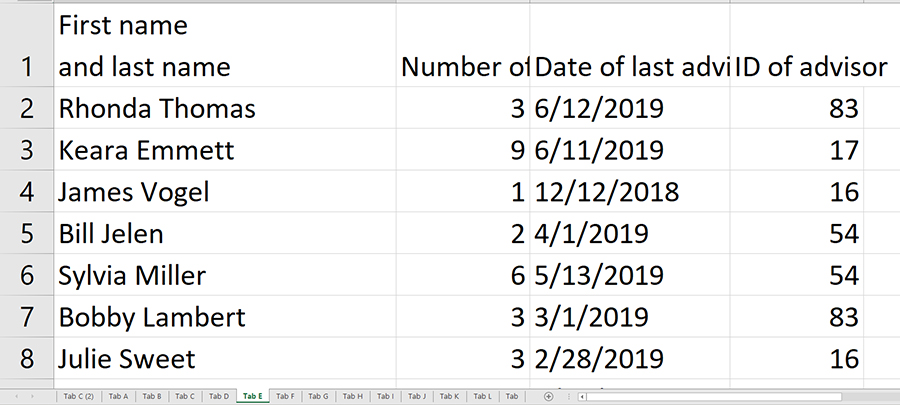- newsletter
- Extra Credit

Format column headings in Excel to make them easier to read
Please note: This item is from our archives and was published in 2021. It is provided for historical reference. The content may be out of date and links may no longer function.
Consider the following spreadsheet that contains information about student advising:

The first row contains the heading for each column. As shown above, the column headings are hard to read because the entire text doesn’t show up due to the column width. There are a few ways we can fix this problem:
- Adjust the column width,
- Format the cell to wrap text, or
- Use control line breaks in the cell.
(Note that these tips will work for any cell, not just column headings.)
Adjust the column width
To increase the column width quickly and easily, you can move your mouse to the far-right edge of the column label area until you see the crosshairs (see below). You then just double-click your mouse, and the column is adjusted to fit the width of the largest content.

If you want to adjust multiple columns at the same time, you can. You will simply select the columns you want to adjust by holding down your Shift key and selecting the continuous columns. Once all of your columns are selected, move your mouse to the far-right edge of the column label area for one of the selected cells. Once you see the crosshairs, double-click the mouse and the adjustment will be made.
Format the cell to wrap text
Another option to adjust the column headings is to format the cell to wrap text. This will allow the text to be on multiple lines as shown below.

To do this, you should select the cells you want to have wrapped text and then right-click. A menu will open and you should select Format Cells. In the Format Cells box, select the Alignment tab, check Wrap text, and then click OK.

Your column headings text is now being displayed on multiple lines.
Use control line breaks in the cell
Sometimes, when using the previous technique, you might not like where the break in the line occurs. You can control where you want the next line to start in a cell by using line breaks. In this example, say you want to add a line break between “First name” and “and last name.” Double-click in the cell you want to adjust and then move your cursor to where you want the line break. On your keyboard, key Alt and Enter at the same time. (If you are a Mac user, you will key CTRL, OPTN, and ENTER at the same time.)

You will now have a line break exactly where you want it in your column heading:

— Wendy Tietz, CPA, CGMA, Ph.D., is a professor of accounting at Kent State University in Kent. Ohio; Jennifer Cainas, CPA, DBA, is an instructor of accountancy at the University of South Florida in Tampa; and Tracie Miller-Nobles, CPA, is an associate professor of accounting at Austin Community College in Austin, Texas. See their site AccountingIsAnalytics.com for resources they have developed for teaching data analytics in introductory accounting. To comment on this article or to suggest an idea for another article, contact JofA senior editor Courtney Vien at Courtney.Vien@aicpa-cima.com.



















